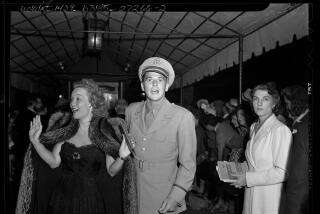An Evolutionary Jungle : THE GREAT DIVORCE, <i> By Valerie Martin (Doubleday: $22.50; 340 pp.)</i>
- Share via
Valerie Martin’s “The Great Divorce” is the kind of fiction that can briefly refocus and broaden the scope of what we notice about the world. Not long after finishing the novel, I found myself paying rapt attention to a TV advertisement for a collection of videotapes that seemed made up of scenes of snarling jungle creatures ripping each other to shreds. “Find out why we call them animals,” droned the portentous voice-over.
The question of who we are to call them animals, of what distinguishes us from our near neighbors on the evolutionary ladder, is one that has frequently engaged Valerie Martin--in her story collection, “The Consolation of Nature,” and also in her novels, most recently, “Mary Reilly,” whose heroine was the servant of the all-too-human Dr. Jekyll and the beastly Mr. Hyde.
In her intellectually ambitious and readable new book, she employs three distinct, interlocking and thematically related narratives as a prism with which to refract and study the laser-thin bands of light and darkness that divide supposedly socialized humans from purely instinctive, ravening beasts. The three plots form a sort of triptych with the central and most fully drawn panel depicting a succession of upheavals in the life of Ellen Clayton, a dedicated veterinarian employed by the New Orleans zoo, with a tolerably troubled marriage and two spirited young daughters. As Ellen struggles to combat a deadly viral infection threatening the zoo population, she fails to notice, until it’s too late, that her marriage is in serious jeopardy, and that her daughters are less resilient than she had imagined.
Opening out from this pivotal drama (again, like the panels of a triptych) are two less conventional narratives, both of which concern young women with mysterious and somewhat less than healthy psychic connections to cats--and feline violence. Like Ellen, 19-year-old Camille also works at the zoo; she takes care of the lions, leopards and tigers. Unsurprisingly, Camille feels closer to the animals in her charge than to her nasty, destructive mother and to the disheartening array of men with whom Camille engages in alienated and degrading sex. The third and final story line involves a figure from the last century, Elizabeth Schlaeger, the so-called “catwoman of St. Francisville”--convicted and executed in the 1840s for the murder of her husband. In the course of his historical research, Ellen’s husband Paul gradually uncovers the disturbing events of Elizabeth’s brief, tragic life and death.
Though the actual weather in the novel is typical of hot, humid New Orleans, we feel somehow that the book’s main events are all occurring under darkening thunderclouds and over the ominous rumble of a violent, gathering storm. This aura of mounting tension helps connect the three interwoven plots, as does the wide-ranging curiosity and considerable intelligence of Ellen, the book’s most accessible and sympathetic character.
Ellen’s meditations on our progressively attenuated relationship to the natural world provide a unifying philosophic dimension to these cautionary tales of women pushed to the point at which the thin cloak of civilization drops, with dire result, from their shoulders. “The Great Divorce” of the title does not refer solely to its heroine’s unraveling marriage but also to the “breakup between the human species and the rest of nature, which like all divorces was causing pain in many quarters.” Some of the most incisive sections of the book concern the evolution--or de-evolution--of our attitude toward wildness and our efforts to keep it at bay:
“How ironic that the only animal capable of appreciating natural beauty is the one bent on destroying it, the one capable of actually creating ugliness.”
It’s to Valerie Martin’s credit that she has been able to write this nervy, risk-taking novel--so fraught with all the trappings of High Gothic heartbreak and violence, with cat women prowling antebellum plantations and the decadent New Orleans art scene--without ever descending into the sort of purple, overwrought heavy-breathing that Anne Rice has unleashed upon the world. “The Great Divorce” is impressively controlled and restrained, and it seems as if the writer is having fun with amusing (and unattributed) quotes from the cinematic versions of “Cat People,” the original Jacques Tourneur film and Paul Schrader’s more recent homage.
Only near the very end does a hint of murkiness cloud these otherwise clear waters, as Ellen’s reflections (and the book’s sentence structure) grow more convoluted, until they require more effort to disentangle than, we fear, they may repay.
But these are minor failings in an otherwise fine novel that most often engages our sympathy--as well as out intellect. “The Great Divorce” provides the immediate pleasures of a literary page-turner, but also has a more lasting influence, an effect that we know has stayed with us as we suddenly sit up to watch the tiger tearing its prey on our flickering TV screen.
More to Read
Sign up for our Book Club newsletter
Get the latest news, events and more from the Los Angeles Times Book Club, and help us get L.A. reading and talking.
You may occasionally receive promotional content from the Los Angeles Times.










